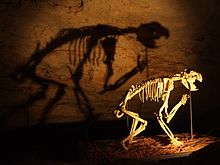Thylacoleo carnifex
| Thylacoleo carnifex | ||||||||||||
|---|---|---|---|---|---|---|---|---|---|---|---|---|

Live reconstruction of Thylacoleo carnifex |
||||||||||||
| Temporal occurrence | ||||||||||||
| Pleistocene | ||||||||||||
| 1.81 million years to 45,000 years | ||||||||||||
| Locations | ||||||||||||
| Systematics | ||||||||||||
|
||||||||||||
| Scientific name | ||||||||||||
| Thylacoleo carnifex | ||||||||||||
| Owen , 1858 | ||||||||||||
Thylacoleo carnifex (also called " marsupial lion ") is an extinct species of marsupial from the order of the Diprotodontia . It was the best known and largest animal of the marsupial lion family(Thylacoleonidae), which has been fossilized since the late Oligocene . Thylacoleo carnifex appeared around 1.8 million years ago in the Pleistocene and only became extinct around 45,000 years ago.
description
This animal reached a length of around 1.5 m and a body weight of more than 110 kg; However, individual skulls suggest individual animals weighing significantly more than 150 kg. Thylacoleo carnifex was an extremely sturdy predator with strong muscles, which is why it reached a very high weight despite its rather short body length. The front legs and shoulders in particular were strong and the thick bones gave strong muscles support. Approximately in the middle of the humerus (upper arm bone) sat a regular cusp on which very strong muscles were attached. They allowed the animal to hold onto large and defensive prey with its thumb claws. One of its most striking features was the splayable thumb of the front paw, which was probably used to hold the prey. The prey was probably stabbed to death with the long incisors of the lower jaw, and the molars, which were shaped into huge cutting scissors, were divided. Thylacoleo carnifex had the most powerful fangs of all known mammals . Even in the big cats, which also specialized in large animals, such as lions and tigers or the various extinct saber-toothed cats , these teeth were not as pronounced. In addition, Thylacoleo had a very high bite force , possibly stronger than all other known predatory mammals. However, in this respect his skull was built completely differently than that of the placental mammals or most predatory marsupials such as marsupial devils or pouch martens. Because instead of the otherwise strongly developed temporalis muscle , which originates at the temples , these animals had a huge masseter muscle , which originates in the upper jaw. Such a shape is actually more likely to be found in herbivores , but there is no question that thylacoleonides were carnivores. The cause is the evolution of the thylacoleonids, because these highly specialized carnivores were actually descendants of herbivorous marsupials that were similar to koalas . It was not until a short time ago that these animals began to develop from herbivores to omnivores and finally to highly specialized carnivores. Some early forms were only as big as cats and appear to have eaten more insects and small vertebrates , while the youngest and largest species, Thylacoleo carnifex , appear to hunt even the rhinoceros-sized diprotodons , as bite marks on the bones of these huge marsupials show.
Way of life

The diet of Thylacoleo carnifex has long been controversial. While all other animals of the order Diprotodontia are herbivores or omnivores, the marsupial lion's teeth indicate that it was feeding on meat. Its first describer, the paleontologist Richard Owen , described it in 1859 as "one of the wildest predators ever". Other researchers said that it fed on carrion or even, because Diprotodontia are not carnivores, on plants. Recent studies of the skull and jaw have shown that it was clearly a carnivore, perhaps one of the best-adapted in the entire mammal kingdom.
Extinction Period and Human
The first Aboriginal ( Aboriginal ) may yet met these animals, but this debate since the 1980s controversy in science, as well as the reasons for the extinctions of Australian megafauna and whether Homo sapiens it played a role . A rock carving in Kimberley , Western Australia, has been interpreted as depicting a Thylacoleo carnifex . This would mean that people who settled more than 45,000 years ago (other figures: more than 60,000 or 65,000 years ago) Sahul (the name of the shelf area of Australia and New Guinea) met Thylacoleo carnifex , which became extinct about 45,000 years ago. Other interpretations contradict this.
Web links
Individual evidence
- ↑ S. Wroe, TJ Myers, RT Wells, A. Gillespie: Estimating the weight of the Pleistocene marsupial lion, Thylacoleo carnifex (Thylacoleonidae: Marsupialia): implications for the ecomorphology of a marsupial super-predator and hypotheses of impoverishment of Australian marsupial carnivore faunas. In: Australian Journal of Zoology Volume 47, No. 5, 1999, pp. 489-498.
- ↑ Stephen Wroe, Colin McHenry, Jeffrey Thomason: Bite club: comparative bite force in big biting mammals and the prediction of predatory behavior in fossil taxa. (PDF) In: Proceedings of the Royal Society B: Biological Sciences Volume 272, No. 1563, 2005, pp. 619-625.
- ^ Richard Cosgrove et al .: Overdone overkill - the archaeological perspective on Tasmanian megafaunal extinctions. (PDF) In: Journal of Archaeological Science. Volume 37, No. 10, 2010, pp. 2486-2503.
- ↑ Kim Akerman, Tim Willing: An ancient rock painting of a marsupial lion, Thylacoleo carnifex, from the Kimberley, Western Australia. In: Antiquity. Volume 83, No. 319, March 2009.
- ↑ Ken Mulvaney: Iconic imagery: Pleistocene rock art development across northern Australia. In: Quaternary International. Volume 285, 2013, pp. 99-110.
- ↑ Kerensa McElroy: Marsupial lion found in Aboriginal rock art In: Cosmos Online. May 27, 2009.
- ^ F. Donald Pate et al .: Last recorded evidence for megafauna at Wet Cave, Naracoorte, South Australia 45,000 years ago. (PDF) In: Australian Archeology. 2002, pp. 53-55.
